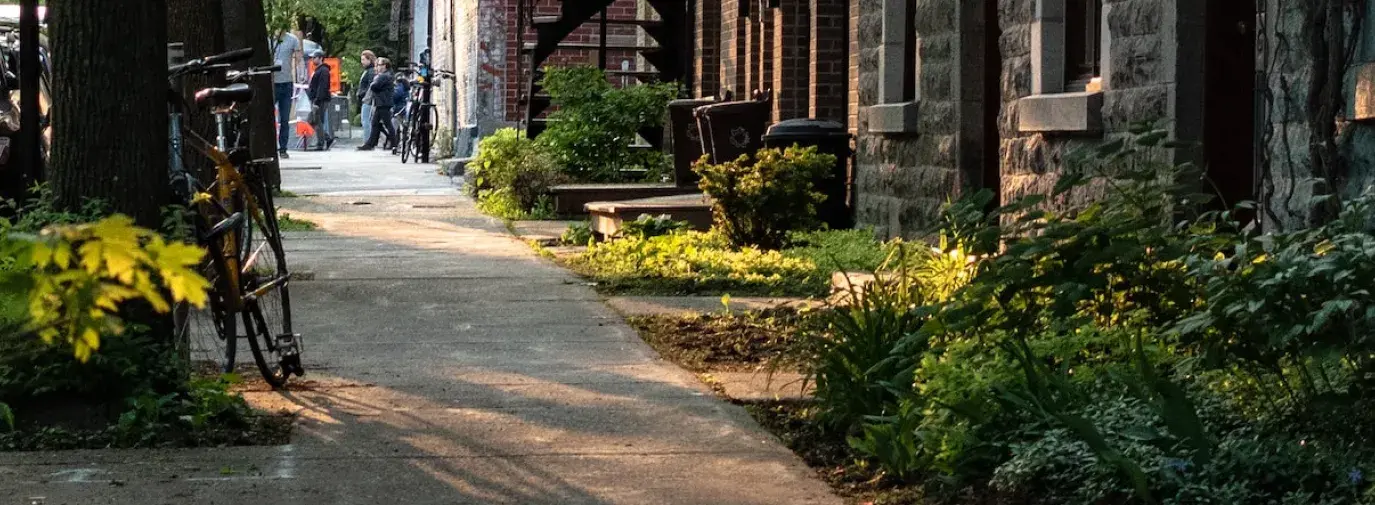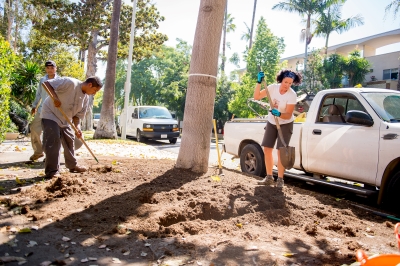
Imagine driving 45 minutes to buy a fresh tomato. That’s what Ron Finley’s South Central Los Angeles community had to do before he began growing food in a parkway next to his house in 2010. In that narrow strip of earth between the sidewalk and street opposite the Farmdale metro station, he sowed the seeds of a movement to convert these barren rectangles into gardens that serve people and the planet.
What is a parkway garden?
It’s all about intentionally growing vegetables, fruits, herbs, or flowers in that space between your sidewalk and street—the parkway, also called a planting strip, treelawn, hellstrip and dozens of other names.
Just like all other types of landscaping and gardening, your parkway garden will be unique to you. The plants that do best are adaptable, durable, and low-lying native plants that require minimal care. If your parkway is paved over, a container garden in this area could still be an option.
Parkway gardens and other forms of urban gardening are taking hold across the country. From California to New York, people are reclaiming previously ignored patches of dirt close to their homes, planting gardens to brighten America’s neighborhoods via these greenspaces. In suburban River Forest, Illinois, alone, the community’s Sustainability Commission has created 36 parkway gardens.
Why are parkway gardens important?
They may be small spaces, but taken together, parkway gardens can help solve some of the biggest human-caused ecological challenges, including polluted runoff, flooding, biodiversity loss, and the climate crisis.
Enhancing parkways with native plants can reduce the contaminants headed for our streams and seas since the vegetation intercepts and filters that runoff. The plants boost floodwater retention because their roots and soil biodiversity form conduits that enable the ground to soak up excess water.
Parkway gardens support aboveground biodiversity by providing food and habitat for at-risk pollinators, birds, and other wildlife. What’s more, these spaces can also draw down atmospheric carbon if grown using Climate Victory Gardening practices, locking planet-warming carbon dioxide in the soil.
And, of course, they beautify the stark pavement and foster passersby’s wellbeing. In fact, research shows that such greenspace can lower violent crime in cities.

How do you plant a parkway garden?
Follow these steps to turn an overlooked parkway near you into a lush garden:
- Ask your local government whether you must obtain permission to modify the parkway or follow specific maintenance rules—every municipality is different, but you can start by contacting the sustainability, transportation, public works, or parks and recreation department. Before breaking ground, check with utility companies about cables and pipes to avoid hazardous accidents and service disruptions while digging. If your neighborhood has a homeowner’s association or similar regulatory body, consult them, too. Your city might also offer assistance. For instance, Washington, D.C. plants trees in parkways for free upon request.
- Choose up to a dozen species to start, Sunset Magazine suggests. It’s okay to keep it simple with fewer and expand later. Go for enduring plants like perennials, shrubs, and bulbs that are native to your area, don’t need much water, and stay below 3 feet tall without obstructing passersby’s path. You might choose a small fruit tree to provide food for the community and wildlife. To maximize beauty, harvest diversity, and consistent pollinator feed, incorporate a medley of shapes, textures, bloom times, and edible produce.
- Eliminate nonnative plants already growing in the area. Excavate them and cover the plot with sheet-mulching to build soil health and prevent future weeds. If you’d like, use stones or bricks to build a buffer around your garden.
- If the earth is compressed and lifeless, add a couple inches of well-decomposed manure or compost. Avoid planting directly under trees and nearby shallow roots.
- Put plants a little closer than usual to speed their spread and fill in the space. Add an inch of mulch to protect soils and decrease maintenance.
- Water weekly for a few months if rain is infrequent, and continue weeding until the parkway fills in.
How else can you produce food with limited space?
If parkway gardening isn’t an option, there are still many easy ways to get your hands dirty growing food. Consider replacing ornamentals in your existing landscaping with food-bearing species. For a rewarding social experience, join a community garden, or find an empty lot to launch one yourself (abide by local restrictions). No matter how you decide to garden, have fun connecting with the earth and enjoy your delicious homegrown bounty.
Remember to add your garden to the Climate Victory Gardens map to showcase your commitment to curbing carbon pollution through building and harnessing the soil!






